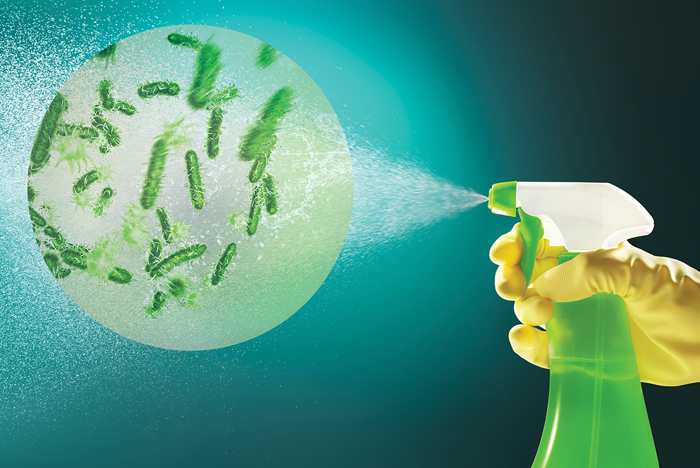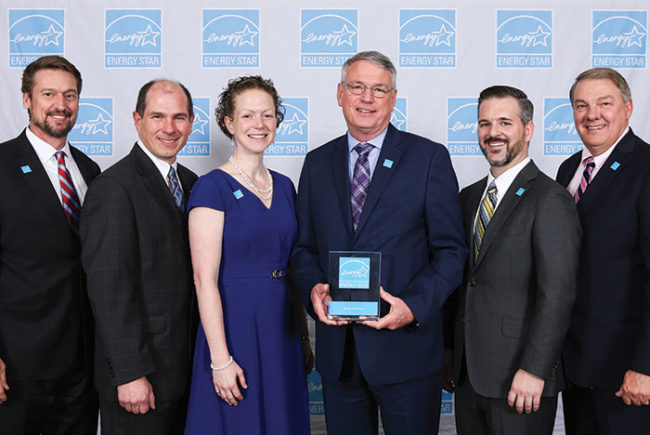
The EPA is tasked with ensuring that products are safe and effective at killing targeted organisms.
Photo by Getty Images
Under the Federal Insecticide, Fungicide and Rodenticide Act, the Environmental Protection Agency (EPA) has jurisdiction over the registration, labeling, sale, distribution and use of pesticidal products that include noncritical, hard-surface disinfectants used every day in hospitals.
The EPA is tasked with ensuring that the products used to kill bacteria, viruses and bacterial spores on environmental surfaces are safe for use and effective at killing the targeted organisms on a label. The Antimicrobials Division (AD) and the EPA’s Microbiology Laboratory of the Biological and Economic Analysis Division (BEAD) at the Office of Pesticide Programs (OPP) work together to develop guidance documents on appropriate and standardized laboratory testing of disinfectants.
They utilize methods from standard-setting bodies like ASTM International and AOAC International, partner with stakeholder laboratories, and run efficacy ring trials and sophisticated statistical packages to develop or improve the standards for hard-surface hospital disinfection.
Updating and refining
The EPA has been busy the last few years refining and updating laboratory methods and adding new techniques to the menu of options for registrants and end users. The EPA’s focus has been on health care environments and the organisms or challenges faced in these use sites.
In March 2017, for instance, EPA’s AD and BEAD released a new guidance document detailing the methodologies and data requirements for registering claims against the emerging pathogen and multidrug-resistant Candida auris. The following August saw the release of methods and registration guidance for claims against biofilms of public health importance. In February, both guidance on laboratory testing of disinfectants with Clostridium difficile claims and the overarching microbial efficacy guidelines were updated.
Testing changes
Among these changes are the following alterations to the EPA’s testing guidelines:
- Updated product performance test guidelines. The EPA’s Product Performance Test Guidelines for Antimicrobial Pesticides Series are often abbreviated to “the 810s,” a reference to their numerical designations. These guidelines provide efficacy standards that must be met to market and sell an EPA-registered antimicrobial product. EPA recently updated 810.2000 through 810.2200 with further 810s in the works. The updated 810s cover general considerations for testing products (810.2000); sterilants, sporicides and decontaminants (810.2100); and disinfectants (810.2200).
- The most obvious revisions include a reorganization and more user-friendly approach to format, including some helpful summary tables.
- New elements include directions for “wetness” testing of disinfectant towelettes or wipes, a new performance standard for viral claims, new standards for testing products diluted on-site and the addition of new or updated guidance on biofilm and C. difficile. The EPA has stated that these guidance documents should be regarded as “living documents” and have been actively engaged with registrants on interpretation of the changes.
- Suspension and planned revamp of EPA’s antimicrobial-testing program. The EPA’s antimicrobial-testing program (ATP) originally was developed to verify that EPA-registered hospital disinfectants, sterilants and tuberculocidal products in the marketplace would continue to meet stringent efficacy standards.
- Under the program, EPA’s laboratories or state laboratories under contract to the EPA collected and tested samples of in-market antimicrobial products for efficacy. Companies whose products fell short of EPA standards were subject to regulatory or enforcement actions.
- In 2016, the Office of Inspector General (OIG) released a report on the EPA’s ATP, recommending its suspension and the development of a risk-based strategy to ensure the effectiveness of public health pesticides (including disinfectants) used in health care settings.
- Criticisms of the program included redundancies in the EPA’s reregistration program and ATP testing, the small number of products tested on a one-time basis over the previous three years and a lack of focus on some of the most serious agents of health care-associated infections.
The suspension of the program does not mean that disinfectants on the market are not being scrutinized by the agency. In fact, the EPA continues to review product-specific data of existing products through the reregistration process, ensuring that data substantiating both safety and efficacy are meeting current standards. The EPA is actively engaged in the development of a risk-based testing strategy in response to the OIG recommendations. This proposed strategy will help to ensure the effectiveness of public health pesticides used in hospital settings by:
- Establishing a framework for periodic testing after registration;
- Defining a program that is responsive to current public health risks;
- Identifying risk factors for selecting products to test;
- Establishing a process to be used for obtaining samples for testing;
- Setting a date to begin risk-based, post-registration testing.
The EPA is expected to release this strategy in November.
Specific challenges
In addition to changes to overall testing programs, the following guidances for specific challenges have been issued:
- Interim guidance on C. auris. The news of the first cases of the emerging fungal pathogen C. auris in the U.S. in 2016 led to collaborative efforts between the Centers for Disease Control & Prevention and the EPA to define suitable guidance for its disinfection. November 2016 saw the first guidance released by the EPA advising the use of EPA-registered hospital disinfectants effective against fungi. Later, in February 2017, a more conservative approach replaced this guidance and advised the use of products with C. difficile sporicidal claims from the EPA’s List K. The change in the guidance by both agencies may be attributed to the serious nature of the pathogen, including a high mortality rate, persistence in the environment and a lack of published data on the effects of both physical (UV) and chemical disinfection of C. auris.
- From a microbial physiology perspective, spores of C. difficile should be much harder to kill than yeast cells of C. auris, thus the use of sporicidal products gives an end user an assurance of kill in the absence of registered claims. Following the generation of data by the EPA on a range of hospital disinfectants, new guidance was released in March 2017 detailing the pathway to test and register such claims. The release of this guidance did not follow a process of public review and comment because it was deemed necessary to expedite release of the document in the interest of public health.
- In a departure from the traditional methods used to test Candida species (e.g., C. albicans), registrants are required to use a method that is similar to the C. difficile test method whereby a drop of yeast (C. auris isolate) and simulated soil is dried on a stainless-steel disk and treated with a disinfectant. After the desired contact time, the chemistry is neutralized and survivors are quantified. Two batches of product must be tested on two separate days, achieving a minimum of a 5-log reduction on each day.
- Due to the newness of the method and lengthy testing and registration processes, these types of claims may take some time to get to market. However, it is likely that EPA-registered claims against C. auris on hospital disinfectants will become commonplace in the next few years.
- Biofilm guidance. The ability of many microorganisms to develop biofilms on environmental surfaces increases their ability to survive adverse environmental conditions, including certain cleaning and disinfectant treatments. Biofilms in health facilities are likely to occur in moist and hard-to-clean areas such as sinks, showers and toilets. These microbial communities may comprise robust biofilm-forming bacteria such as Pseudomonas species that produce a thick and sticky matrix which can, in turn, contain and shelter other infectious organisms.
- The EPA guidance document released in August 2017 conveys a path for disinfectant manufacturers to substantiate and register claims of effectiveness against bacteria in biofilm. Through a unique academic-governmental collaboration, the EPA and Montana State University’s Center for Biofilm Engineering developed methods for the growth and efficacy testing of biofilms of health importance.
- The method utilizes a lab-based reactor to grow biofilm of either Pseudomonas aeruginosa or Staphylococcus aureus on small glass discs that can later be exposed to disinfectants to test their effectiveness. To be eligible for this new claim, a product must pass a series of six tests (three for each microorganism) and achieve a 6-log reduction of bacteria in biofilm in all tests.
- Although level of rigor in this testing regime should give customers confidence in these new claims for certain use sites (e.g., sinks and drain covers), additional data are required by registrants to substantiate biofilm kill inside an actual drain.
- C. difficile guidance. The increased importance of C. difficile as an agent of health care-associated infections has led to a parallel increase in disinfectant products with activity against spores of this organism. The methodology for testing the efficacy of these products also has been evolving.
- Prior to 2013, disinfectant manufacturers could choose from three test methods to evaluate their products. The methods themselves and the lab-based spore preparation techniques had some fundamental differences, which prompted the EPA to release interim guidance in 2013 requiring the use of one spore-preparation method and one standard-efficacy method. The addition of an interfering substance to mimic bodily fluids was made an optional part of the test procedure.
The EPA continued to work on improvements to available methodology and embarked on a multilab collaborative study to optimize and standardize spore preparation. Having standardized spore material to test a sporicidal disinfectant is paramount to reliable data.
Depending on the growth and handling of biological systems such as C. difficile, spores of varying robustness can be created. For a method to be used as a valid regulatory tool, the standardization of spore preparation ultimately leads to a level playing field where all disinfectants are subjected to the same challenge across laboratories.
The microbiologists of the EPA included a robustness test to qualify spores based on the spores’ tolerance to a standard bleach treatment. A draft guidance document was released in 2017 detailing method changes in addition to new testing and labeling requirements for disinfectant manufacturers. There were some challenges made to method details and to some of the labeling language used in this draft. Of importance to infection prevention specialists was the deletion of wording related to high-touch objects in a cleaning regimen.
The EPA worked with stakeholders to adjust parts of the guidance and reinstated language on high-touch surfaces. In February, the EPA released a final guidance that includes a mandatory addition of simulated bodily fluid, an addition welcomed by public health stakeholders and some flexibility in the types of materials used as model surfaces for testing products.
The C. difficile test method is a basic quantitative carrier-type test method in which a drop of spore material and simulated soil are dried on a stainless-steel carrier and treated with a disinfectant. After the desired contact time, the chemistry is neutralized and survivors are quantified. The performance standard remains at a minimum of a 6-log reduction of spores and must be achieved with three batches of product on three separate days. Environmental services professionals should be aware that towelettes with C. difficile claims are not tested using a “wiping” method, but rather the liquid from the towelette is expressed and used in the method described previously. In addition, registrants must prove that their towelettes can keep a surface wet for the contact time listed on the label.
Future work by the EPA
The effectiveness of EPA-registered products in the health care environment continues to be an important priority for the OPP.
Stakeholders may expect to see draft 810 guidelines on water and sanitizers, a new towelette test method, and alternative quantitative disinfectant methods all released for public comment in the near future.
The BEAD microbiology lab also has hinted at an upcoming laboratory-based workshop on antimicrobial test methods.
Elaine Black, Ph.D., is senior regulatory manager for Ecolab. She can be reached at Elaine.Black@ecolab.com.




